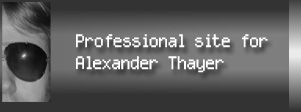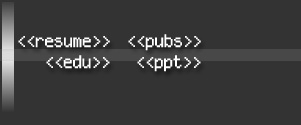

Curriculum Vitae
My current CV is available here as a PDF.
Portfolio Pieces
I am able to present several examples of my professional work in those cases where the non-disclosure agreements have expired. Use the following list to navigate to specific portfolio entries provided below; portfolio pieces are presented in reverse chronological order.
User Experience Product Designer - the Microsoft days (2006-2009)
Solutions Architecture - the Aquent days (2004-2006)
SDK and Other Technical Documentation -
the S&T Consulting days (2000-2002)
SDK and Other Technical Documentation, Tutorials,
Online Help - the Conversa days (1999-2000)
SDK Documentation - the IBM days (1998-1999)
User Experience Product Designer - the Microsoft days (2006-2009)
Overview: As a User Experience Product Designer, I served as a lead within a larger User Experience team. Much of my information architecture work is publicly available in the form of compiled online Help files embedded within the software that drives the keyboard, mouse, webcam, and other hardware products made within our group. To view this content, download the latest software from the Hardware group and view the Help system.
I also served as a product designer on a number of other projects, some of which are available at a consumer electronics store near you. For example, I designed the out-of-box experience (OOBE) for the Microsoft LifeCam Show. By partnering with the Structural Packaging team, I was able to design and develop the OOBE for this product, which is shown in this photo in greater detail. This OOBE was a breakthrough in terms of how we designed the process informing users about how to set up a complex consumer product. Finally, I created the print manual for this webcam as well, part of which you can view here as a JPG.
Much of my User Experience design work focused on creating logical flows of information that would guide users successfully through complex software processes. For example, for version 2.0 of the LifeCam software, I designed the setup interaction logic in Visio, made wireframes of the dialogs and flow in Illustrator, wrote the dialog text, defined the number of screens needed for each possible path through setup, and redeveloped all of the post-setup pop-ups.
Please contact me privately to discuss my other work in this role, much of which remains confidential.
Solutions Architecture - the Aquent days (2004-2006)
Overview: As the Senior Solutions Architect at Aquent (formerly Sakson & Taylor), I was the lead information architect who consulted on potential projects for new and existing corporate clients. Essentially all of the work I developed in this role remains confidential, unfortunately, so you will need to contact me for additional details about my work as a Solutions Architect.
SDK Documentation - the S&T Consulting days (2000-2002)
Overview: Due to my previous experience in the area of documenting software development kits (SDKs), I worked on two Microsoft SDKs geared toward developers who create applications for handheld Microsoft products: the Pocket PC 2002 SDK project and the Smartphone 2002 SDK project. As part of my job, I conducted interviews with the Microsoft developers who were responsible for building the SDK, I reviewed the specifications and marketing documents that they had created, and I installed and tested APIs using the software device emulator. I also reviewed the public classes and other elements of the code that the Microsoft developers were providing within the SDK, which in many cases lacked any descriptive information.
I documented several application programming interfaces (APIs) for Pocket PC 2002, including the following core elements of the Pocket PC 2002 SDK (all links connect to the MSDN Library and to content that I originally wrote):
- Bluetooth
API
-
Connection
Manager API
-
MIDI
API
-
Phone
API
Although I "owned" these specific areas, I worked on several other APIs as well. I also worked on the more conceptual part of the SDK documentation (the Pocket PC Developer's Guide).
Finally, I performed most of the same work on the Smartphone 2002 SDK that I had performed for the Pocket PC 2002 SDK team. For both SDKs, I participated in review meetings, provided regular updates to the clients, orchestrated builds of the Help files, and served as an internal consultant to the project manager for all matters related to the SDK (budget, scheduling, staffing, client relations, and so on).
SDK Documentation, Tutorials, Online Help - the Conversa days (1999-2000)
Overview: At Conversa (now named Conversay), my first assignment was to document the Conversation Development Kit (CDK), a Macromedia Dreamweaver plug-in. I was an integral part of the CDK team throughout the development process; when I started working on this project, the CDK did not exist. Within five months, the CDK went from a concept to a Beta-level product.
CDK
Developer's Center (separate Web site; please click "Yes" to show
any active content)
I designed and created this help system as a Web-based version of the CDK help
file. I wrote this help system using HTML and JavaScript; I used Macromedia
Dreamweaver 2.0 to write some of the HTML, but I created the JavaScript code
by hand. Although I designed all of the graphics, the color scheme was a corporate standard that looks
extremely ugly by anyone's standards.
Getting Started with the
CDK (3.9 MB, Microsoft Word document)
At first, the CDK was envisioned as a product that would appear in stores nationwide.
I wrote this guide at the request of the project manager; he wanted a guide
that could be professionally printed and included in the CDK package. However,
he eventually scrapped the idea of a shrink-wrapped CDK box, settling for an
Internet-based version of the software instead. I included this document because
it demonstrates my ability to work under pressure (it took me two weeks to write)
and my familiarity with the use of screen shots.
Conversa
Web Express Tutorial (separate Web site; please click "Yes" to
show any active content)
I designed and created this tutorial for first-time users of the Conversa Web
Express browser. Conversa Web Express is a freely available, voice-enabled Internet
browser; this tutorial opens when you start Conversa Web Express for the first
time. I organized the creation of graphics and scheduled an editorial review
of this tutorial. I designed the tutorial to slowly introduce users to the phenomenon
of spoken Internet navigation; the response from the product manager and from
the customers was overwhelmingly positive.
Using HHP Files
(382 KB, PDF)
Microsoft HTMLHelp Workshop is the application that tech writers use to create
compiled Help (CHM) files. This software is notoriously quirky; as I was learning
how to use HTMLHelp Workshop, I realized that Microsoft did not provide detailed
documentation for their product. I decided to write the documentation myself
largely for the benefit of the other writers at Conversa. I wrote the document
using Adobe FrameMaker and created a PDF file for easy distribution and printing.
This document became the canonical reference for all of the other writers, both
at this job and at every job I have held since then.
SDK Documentation - the IBM days (1998-1999)
Overview: At IBM, I worked on a digital database application named Digital Library (DL). I was given two existing documents and told to create new content for them based on the input I solicited from developers. These documents were the backbone of the DL documentation set: They described how to write custom applications that would extend the functionality of DL.
IBM DB2
Digital Library Application Programming Reference (4.5 MB, PDF)
This guide became one of my two major projects when I worked at IBM. The source
document was written in SGML; I converted the documentation from SGML to PostScript
to PDF for distribution to our customers. The text I added to this document
is marked with change bars contained in the left margin of the PDF file. My
work on this project included organizing technical reviews, soliciting information
from developers, and writing original content.
IBM DB2
Digital Library Application Programming Guide (917 KB, PDF)
This guide was my other major project at IBM. When I joined IBM, I was given
this document and facetiously told to "do my best." The document was over 1500
pages long when I inherited it; by the time I left IBM, I had added hundreds
of new pages of content. It was the bulk of this document that prompted me to
design a Web-based interface capable of delivering API information almost instantly.
This work would eventually earn a patent for IBM.
Click
here to view my API documentation interface patent (link leads to an external
site; if the link does not work, search on patent #6,405,216)
Site copyright 2004-2012, all rights reserved by Alexander Thayer